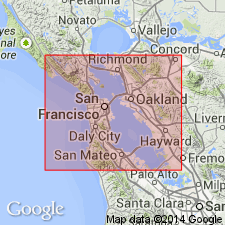
- Usage in publication:
-
- Moraga formation*
- Modifications:
-
- Original reference
- Dominant lithology:
-
- Andesite
- Basalt
- AAPG geologic province:
-
- Sacramento basin
Summary:
Moraga formation of Berkeley group. Chiefly flows of andesite and basalt, with which are associated some basaltic tuffs and beds of well-cemented rhyolite tuff. Between these volcanic rocks lie lenticular beds of conglomerate, clay, and limestone. One of limestone beds contains fresh-water fossils, is 80 feet thick, and has lavas above and below it. One of the conglomerate lenses in places reaches thickness of about 1,200 feet. Is basal formation of Berkeley group. Underlies Siesta formation and unconformably overlies Merced formation. Age is Pliocene.
Named from occurrence in Moraga Valley, Contra Costa Co., San Francisco region, western CA.
Source: US geologic names lexicon (USGS Bull. 896, p. 1418).
For more information, please contact Nancy Stamm, Geologic Names Committee Secretary.
Asterisk (*) indicates published by U.S. Geological Survey authors.
"No current usage" (†) implies that a name has been abandoned or has fallen into disuse. Former usage and, if known, replacement name given in parentheses ( ).
Slash (/) indicates name conflicts with nomenclatural guidelines (CSN, 1933; ACSN, 1961, 1970; NACSN, 1983, 2005, 2021). May be explained within brackets ([ ]).

